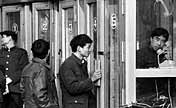

You may have heard of protecting physical relics and tombs, but how about large parts of an entire city? Beijing’s cultural heritage authorities have been pushing hard to get the city’s central axis, an ancient line that marked key routes through the capital and divided the city, recognized as a UNESCO World Cultural Heritage site. The eight-kilometer long axis is among 45 items to be short-listed into the application list.
Beijing’s central axis, which passes through a myriad of ancient buildings and traditional hutongs, is one of the two items in Beijing to be listed as a candidate. The other is Beijing’s section of the Grand Canal. The axis links Yong Ding Gate, the south end of ancient Beijing, to the Bell and Drum Tower, the north end of the ancient capital.
The axis also stretches through to Qian Men, Tian’an Men and the Forbidden city. A large scale renovation project has been underway since May, to renovate the buildings and hutongs along the axis. The inclusion of the axis into China’s application list of world cultural heritage sites will help to protect the feel and look of the ancient capital.
 |
 PLA Macao Garrison finishes 13th rotation
PLA Macao Garrison finishes 13th rotation China's stealth fighter concept model
China's stealth fighter concept model  Frontier-defense soldiers in patrolling
Frontier-defense soldiers in patrolling Heartbreaking children in air strikes
Heartbreaking children in air strikes 3 killed in bombing in Kabul's diplomatic enclave
3 killed in bombing in Kabul's diplomatic enclave Landmark building should respect the public's feeling
Landmark building should respect the public's feeling Herders, sheep flock move to winter pasture
Herders, sheep flock move to winter pasture  Development of telecommunication in China
Development of telecommunication in China First inter-blood-type liver transplant in China
First inter-blood-type liver transplant in China Harbin Autumn Automobile Exhibition kicks off
Harbin Autumn Automobile Exhibition kicks off  Taizhou Yangtze River Bridge to open in E China
Taizhou Yangtze River Bridge to open in E China  Snow scenery in Huma County, NE China
Snow scenery in Huma County, NE China  1st China Puer Int'l Country Music Festival
1st China Puer Int'l Country Music Festival  Kung fu nuns teach cosmic energy to CERN scientists
Kung fu nuns teach cosmic energy to CERN scientists China's affluent population will reach to 280 million
China's affluent population will reach to 280 million